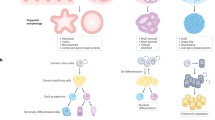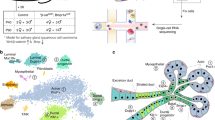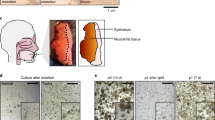Abstract
Refined cancer models are required if researchers are to assess the burgeoning number of potential targets for cancer therapeutics in a clinically relevant context that allows a fast turnaround. Here we use tumor-associated genetic pathways to transform primary human epithelial cells from the epidermis, oropharynx, esophagus and cervix into genetically defined tumors in a human three-dimensional (3D) tissue environment that incorporates cell-populated stroma and intact basement membrane. These engineered organotypic tissues recapitulated natural features of tumor progression, including epithelial invasion through basement membrane, a complex process that is necessary for biological malignancy in 90% of human cancers. Invasion was rapid and was potentiated by stromal cells. Oncogenic signals in 3D tissue, but not 2D culture, resembled gene expression profiles from spontaneous human cancers. We screened 3D organotypic neoplasia with well-characterized signaling pathway inhibitors to distill a clinically faithful cancer gene signature. Multitissue 3D human tissue cancer models may provide an efficient and relevant complement to current approaches to characterizing cancer progression.
This is a preview of subscription content, access via your institution
Access options
Subscribe to this journal
Receive 12 print issues and online access
$209.00 per year
only $17.42 per issue
Buy this article
- Purchase on Springer Link
- Instant access to full article PDF
Prices may be subject to local taxes which are calculated during checkout




Similar content being viewed by others
References
Stratton, M.R., Campbell, P.J. & Futreal, P.A. The cancer genome. Nature 458, 719–724 (2009).
Campbell, P.J. et al. Identification of somatically acquired rearrangements in cancer using genome-wide massively parallel paired-end sequencing. Nat. Genet. 40, 722–729 (2008).
Chin, L. & Gray, J.W. Translating insights from the cancer genome into clinical practice. Nature 452, 553–563 (2008).
Rangarajan, A., Hong, S.J., Gifford, A. & Weinberg, R.A. Species- and cell type-specific requirements for cellular transformation. Cancer Cell 6, 171–183 (2004).
Hamad, N.M. et al. Distinct requirements for Ras oncogenesis in human versus mouse cells. Genes Dev. 16, 2045–2057 (2002).
Hahn, W.C. et al. Creation of human tumour cells with defined genetic elements. Nature 400, 464–468 (1999).
Elenbaas, B. et al. Human breast cancer cells generated by oncogenic transformation of primary mammary epithelial cells. Genes Dev. 15, 50–65 (2001).
Lundberg, A.S. et al. Immortalization and transformation of primary human airway epithelial cells by gene transfer. Oncogene 21, 4577–4586 (2002).
Dajee, M. et al. NF-kappaB blockade and oncogenic Ras trigger invasive human epidermal neoplasia. Nature 421, 639–643 (2003).
Lazarov, M. et al. Cdk4 coexpression with Ras generates malignant human epidermal tumorigenesis. Nat. Med. 8, 1105–1114 (2002).
Horner, M.J. et al. SEER Cancer Statistics Review, 1975–2006 <http://seer.cancer.gov/csr/1975_2007/> (National Cancer Institute, Bethesda, Maryland, 2010).
Egeblad, M., Littlepage, L.E. & Werb, Z. The fibroblastic coconspirator in cancer progression. Cold Spring Harb. Symp. Quant. Biol. 70, 383–388 (2005).
Hu, M. et al. Regulation of in situ to invasive breast carcinoma transition. Cancer Cell 13, 394–406 (2008).
Marx, J. Cancer biology. All in the stroma: cancer's Cosa Nostra. Science 320, 38–41 (2008).
Bissell, M.J., Kenny, P.A. & Radisky, D.C. Microenvironmental regulators of tissue structure and function also regulate tumor induction and progression: the role of extracellular matrix and its degrading enzymes. Cold Spring Harb. Symp. Quant. Biol. 70, 343–356 (2005).
Khavari, P.A. Modelling cancer in human skin tissue. Nat. Rev. Cancer 6, 270–280 (2006).
Tarutani, M., Cai, T., Dajee, M. & Khavari, P.A. Inducible activation of Ras and Raf in adult epidermis. Cancer Res. 63, 319–323 (2003).
Marinkovich, M.P., Keene, D.R., Rimberg, C.S. & Burgeson, R.E. Cellular origin of the dermal-epidermal basement membrane. Dev. Dyn. 197, 255–267 (1993).
Kao, W.T. et al. Investigation of MMP-2 and -9 in a highly invasive A431 tumor cell sub-line selected from a Boyden chamber assay. Anticancer Res. 28, 2109–2120 (2008).
Toruner, G.A. et al. Association between gene expression profile and tumor invasion in oral squamous cell carcinoma. Cancer Genet. Cytogenet. 154, 27–35 (2004).
Kuriakose, M.A. et al. Selection and validation of differentially expressed genes in head and neck cancer. Cell. Mol. Life Sci. 61, 1372–1383 (2004).
Reuter, J.A. et al. Modeling inducible human tissue neoplasia identifies an extracellular matrix interaction network involved in cancer progression. Cancer Cell 15, 477–488 (2009).
Lee, T.L. et al. A novel nuclear factor-kappaB gene signature is differentially expressed in head and neck squamous cell carcinomas in association with TP53 status. Clin. Cancer Res. 13, 5680–5691 (2007).
Forbes, S.A. et al. The catalogue of somatic mutations in cancer (COSMIC). Curr. Protoc. Hum. Genet. 57, 10.11.1–10.11.26 (2008).
Cancer Genome Atlas Research Network. Comprehensive genomic characterization defines human glioblastoma genes and core pathways. Nature 455, 1061–1068 (2008).
Luo, J., Solimini, N.L. & Elledge, S.J. Principles of cancer therapy: oncogene and non-oncogene addiction. Cell 136, 823–837 (2009).
Petersen, O.W., Ronnov-Jessen, L., Howlett, A.R. & Bissell, M.J. Interaction with basement membrane serves to rapidly distinguish growth and differentiation pattern of normal and malignant human breast epithelial cells. Proc. Natl. Acad. Sci. USA 89, 9064–9068 (1992).
Cox, A.D. & Der, C.J. The raf inhibitor paradox: unexpected consequences of targeted drugs. Cancer Cell 17, 221–223 (2010).
Acknowledgements
This work was supported by National Institutes of Health grant AR43799 to P.A.K. We thank A. Oro, P. Marinkovich, H. Chang, D. Felsher, S. Artandi, A. Sweet-Cordero, M. Scott, G. Sen, Z. Siprashvili, M. Kretz and J. Reuter for presubmission review of the manuscript. T.W.R. is the recipient of career development award National Institutes of Health K08AR053195.
Author information
Authors and Affiliations
Contributions
T.W.R. designed the experiments, performed research, interpreted data and wrote the manuscript. J.M.C. performed experiments. D.J.W. helped to analyze expression array data. P.A.K. helped design and interpret experiments and helped write the manuscript.
Corresponding author
Ethics declarations
Competing interests
The authors declare no competing financial interests.
Supplementary information
Supplementary Text and Figures
Supplementary Figures 1–8, Supplementary Tables 1–5 and Supplementary Methods (PDF 2632 kb)
Rights and permissions
About this article
Cite this article
Ridky, T., Chow, J., Wong, D. et al. Invasive three-dimensional organotypic neoplasia from multiple normal human epithelia. Nat Med 16, 1450–1455 (2010). https://doi.org/10.1038/nm.2265
Received:
Accepted:
Published:
Issue Date:
DOI: https://doi.org/10.1038/nm.2265
This article is cited by
-
Advances in cutaneous squamous cell carcinoma
Nature Reviews Cancer (2023)
-
Acoustic and Magnetic Stimuli-Based Three-Dimensional Cell Culture Platform for Tissue Engineering
Tissue Engineering and Regenerative Medicine (2023)
-
Identifying the effectiveness of 3D culture systems to recapitulate breast tumor tissue in situ
Cellular Oncology (2023)
-
Recent Innovations in Strategies for Breast Cancer Therapy by Electrospun Scaffolds: A Review
Journal of Polymers and the Environment (2023)
-
Mutant collagen COL11A1 enhances cancerous invasion
Oncogene (2021)



